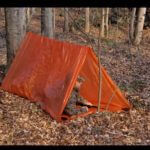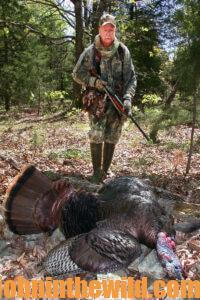 The most-important consideration when deciding where to set-up to call-in a gobbler is to know where a turkey doesn’t want to walk. A gobbler prefers not to…
The most-important consideration when deciding where to set-up to call-in a gobbler is to know where a turkey doesn’t want to walk. A gobbler prefers not to…
…get his feet wet by crossing water;
…fly across water;
…walk through heavy cover or downhill;
…walk under a fence or fly over it;
…move into an area where he’s encountered danger previously; and/or
…go into a region where he thinks another gobbler will beat him in a fight.
If a hunter sets-up in any of these places and tries to call-in a gobbler, chances are good that the bird won’t come to him. However, there are places a turkey enjoys walking. He is very apt to walk in clean woods with little underbrush and in fields where he can see for great distances. He’ll also walk on flat ground whenever possible.
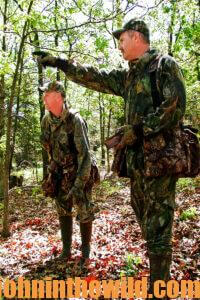 Too, a turkey follows a regular routine. He’s like the old man down the street who goes by the barber shop at 8:15 am, stops at a hardware store to find-out if anyone’s sick, dead or just married, swings by the coffee shop to pick-up a newspaper and a sweet roll and then moves on to the fire station for a game of dominoes. You can set your watch by that old man.
Too, a turkey follows a regular routine. He’s like the old man down the street who goes by the barber shop at 8:15 am, stops at a hardware store to find-out if anyone’s sick, dead or just married, swings by the coffee shop to pick-up a newspaper and a sweet roll and then moves on to the fire station for a game of dominoes. You can set your watch by that old man.
Well, you also can set your watch by an old gobbler in the spring. That bird has a set routine as predictable as the man down the street. Figure out that pattern, and you’ll probably bag the bird. He’ll roost in the same tree, fly-down in the same direction, try to mate in his strutting zones and feed in the same fields. Once you know the routine, then you need to plan the setup.
What’s the Typical Setup for Hunting Turkeys:
One of the problems that a novice hunter has when setting-up on gobblers is that he attempts to get too close to the turkey. The result is that the bird spots the hunter and moves out of that region well before the hunter even tries to call to him. Most often, this happens when a turkey gobbles in the direction of a hunter, turns-around on the limb, faces the opposite direction and gobbles away from the hunter. The bird then sounds farther away than he actually is. A good rule of thumb is to always set-up farther away from the bird than you think you should.
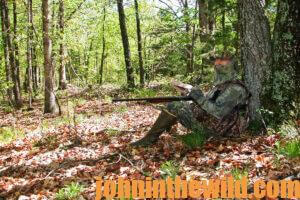 When, Why and Why Not to Change Locations:
When, Why and Why Not to Change Locations:
Although a turkey is sometimes taken on the first setup, that’s by no means typical. More often than not, the hunter must set-up two or three times to call a turkey. Successfully changing calling locations is tricky, but the most-important concern is to know when to move and when to sit still. Many hunters spook turkeys when, after a few minutes of calling, the birds don‘t come in, so the hunter gets up and moves to another location. Often, the hesitant gobbler is spooked by that impatient hunter.
There are times, however, when the hunter must move, or else he won’t get a gobbler. Maybe there’s a creek or a ditch of which he’s not aware. Perhaps the gobbler has encountered some hens and started to walk-out of the area. The turkey may be call-shy, because of other hunter encounters. Or, the ole bird may just be ornery and decide, “If that hen wants to be bred, she’ll have to come find me.”
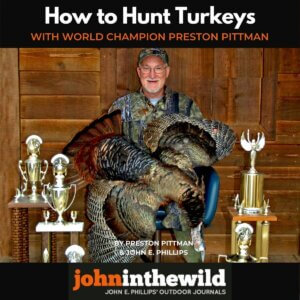 When you move from spot to spot, change calls. Hopefully, the gobbler will think that there’s yet another hen that’s out looking for him. Sometimes, an aggressive hunter will change his position several times. But by moving, he often spooks the tom. Experienced hunters say that patience bags more gobblers than running and gunning.
When you move from spot to spot, change calls. Hopefully, the gobbler will think that there’s yet another hen that’s out looking for him. Sometimes, an aggressive hunter will change his position several times. But by moving, he often spooks the tom. Experienced hunters say that patience bags more gobblers than running and gunning.
To learn more about hunting turkeys successfully, visit John E. Phillips’ Amazon book page at https://www.amazon.com/John-E.-Phillips/e/B001HP7K6O. For even more information from one of the top turkey hunters and callers, go to https://www.amazon.com/gp/product/B00CFP9V2Q/ref=dbs_a_def_rwt_hsch_vapi_taft_p1_i2 to see the book, “How to Hunt Turkeys with World Champion Preston Pittman,” available in Kindle, print and Audible. You may have to copy and paste this link into your browser. (When you click on the book, notice on the left where Amazon says you can read and hear 10% of the book for free). On the right side of the page and below the offer for a free Audible trial, you can click on Buy the Audible book.
Tomorrow: Why Set Up on a Turkey with Hens




